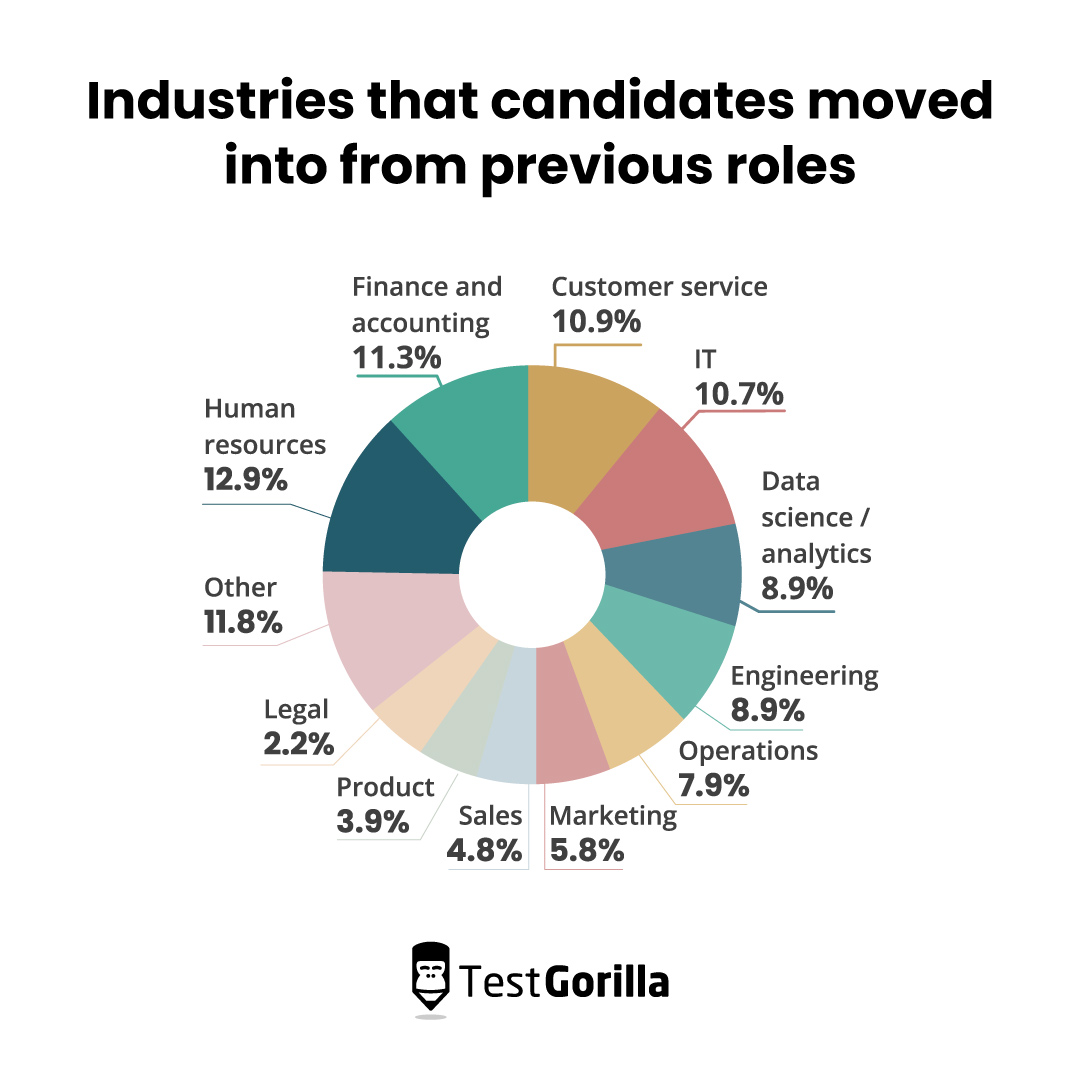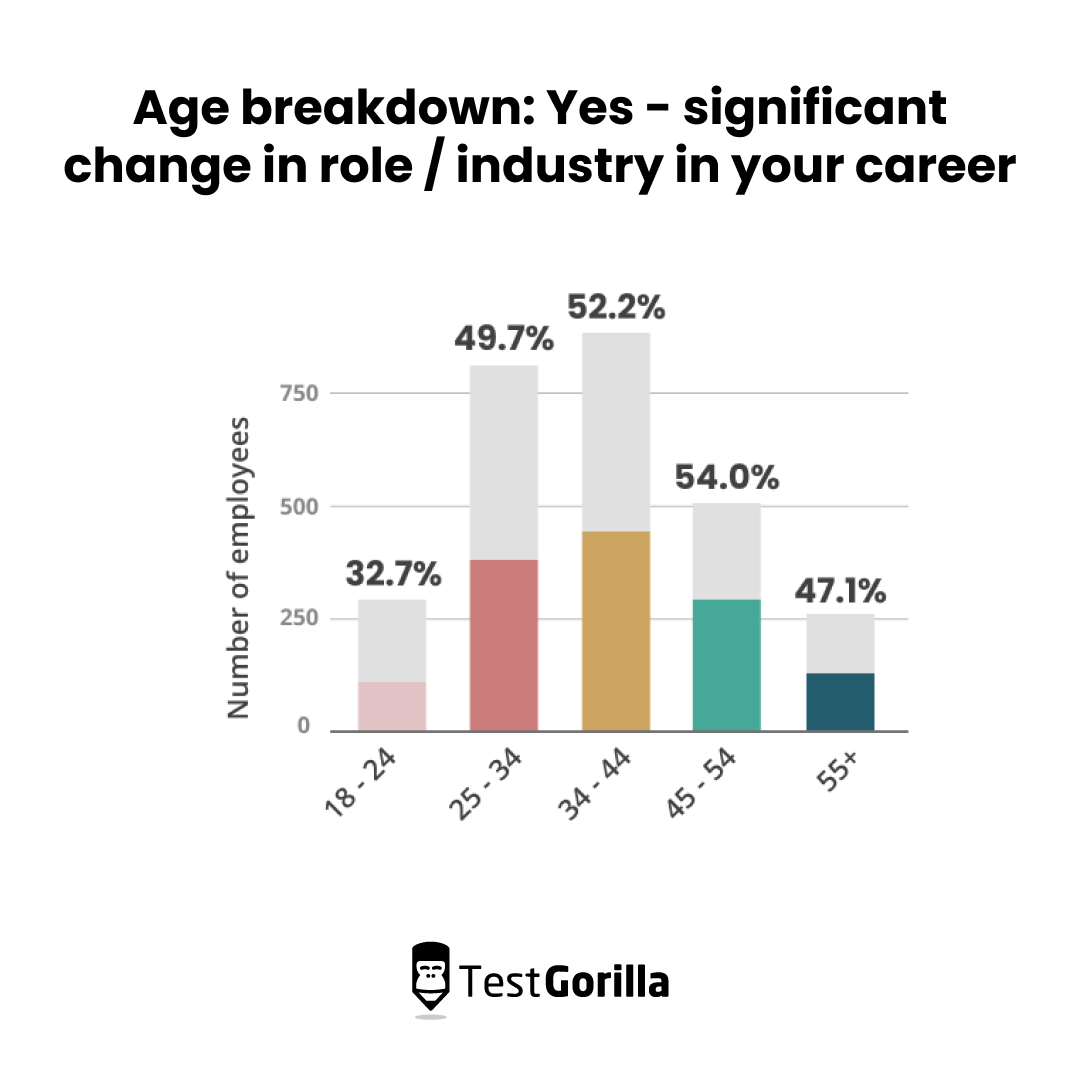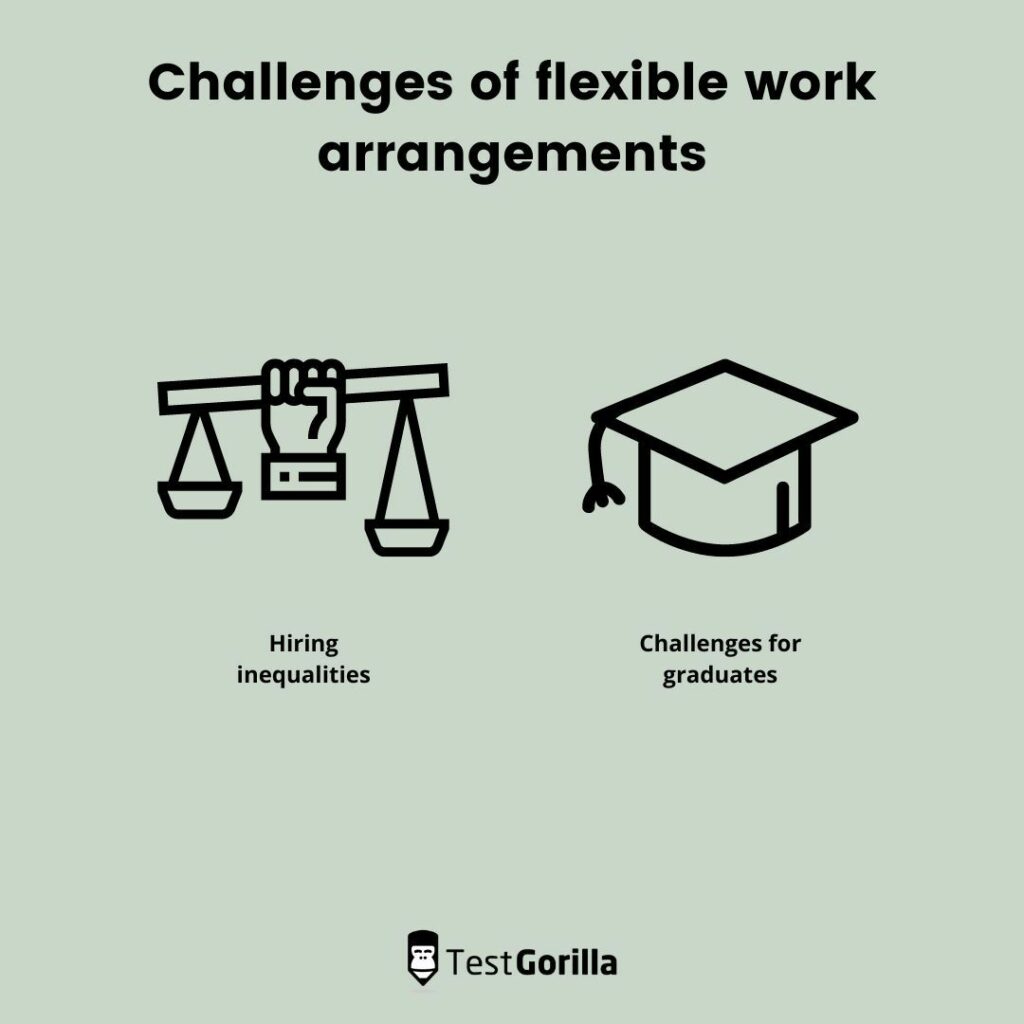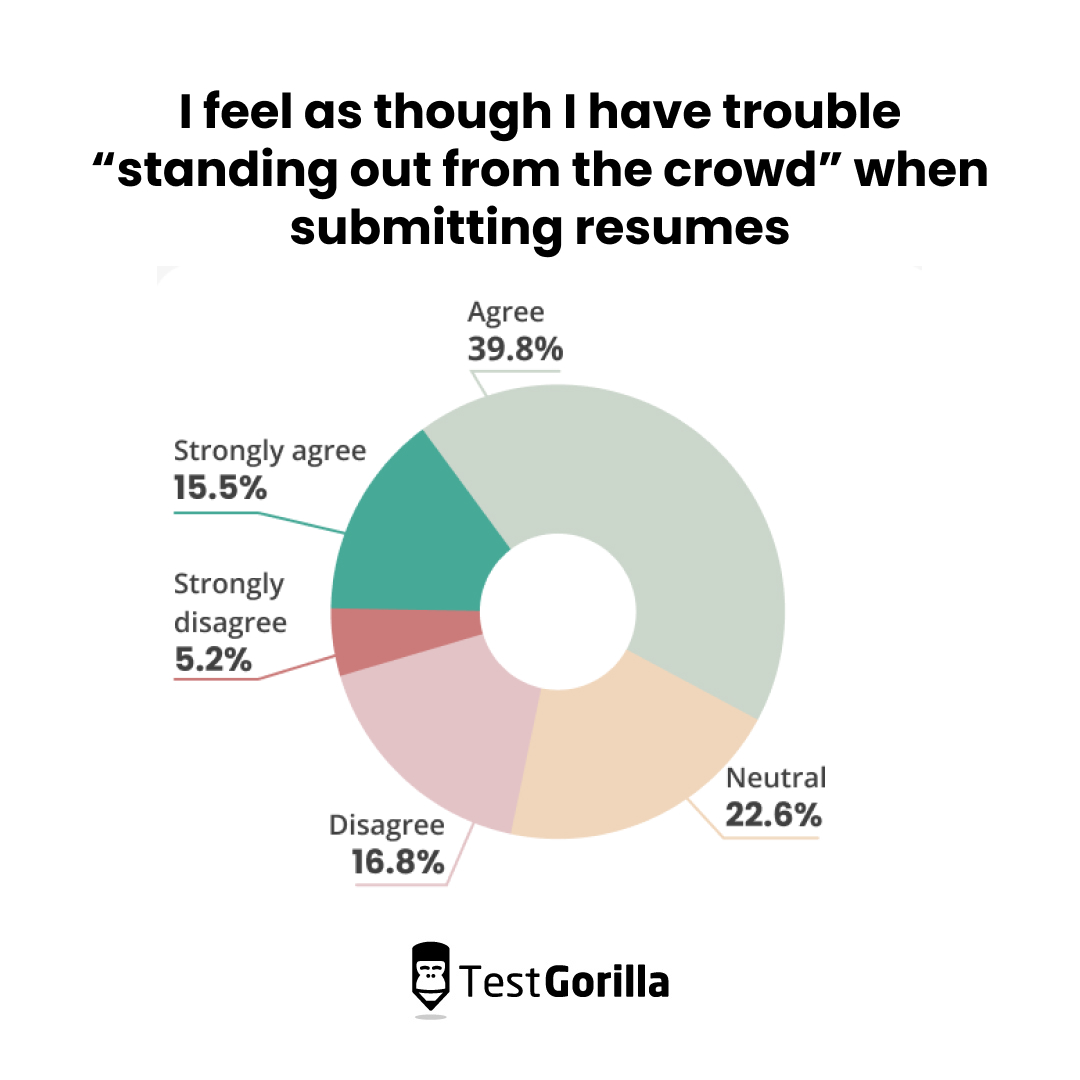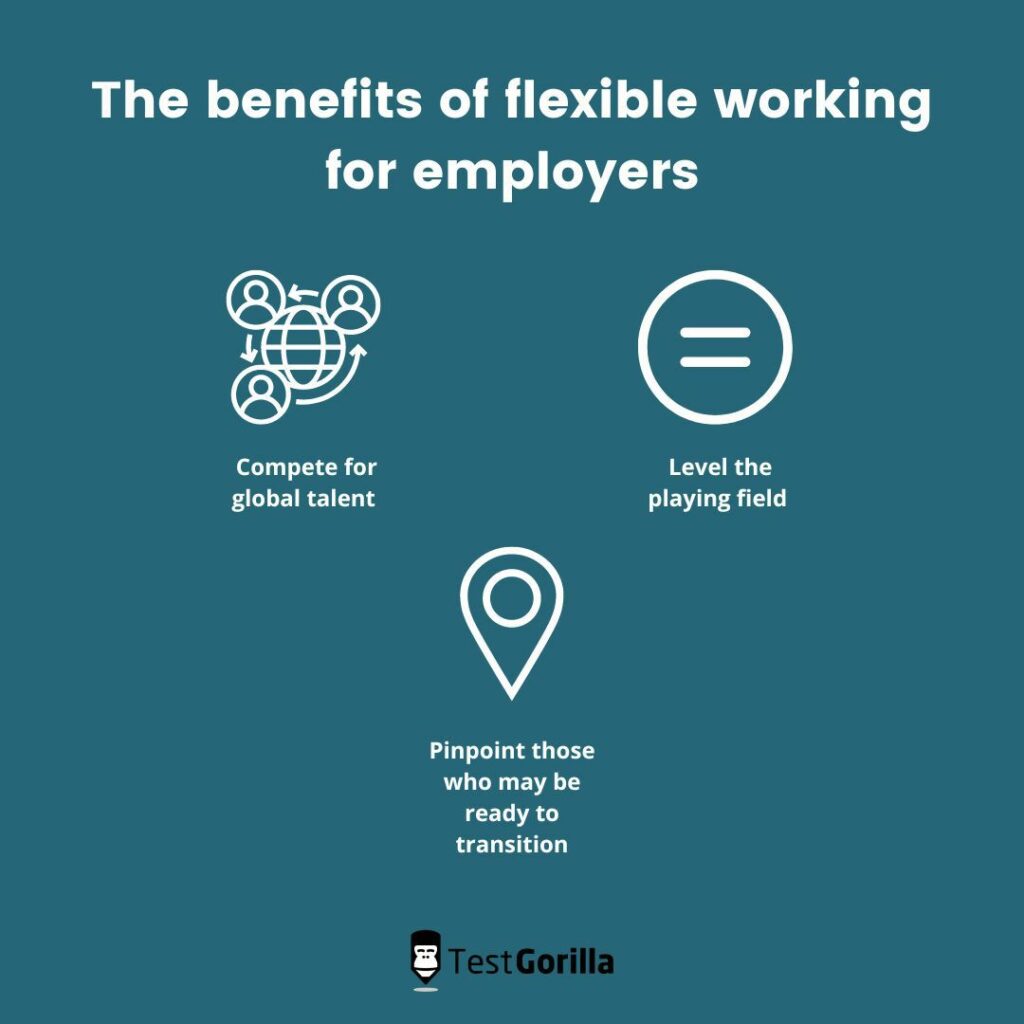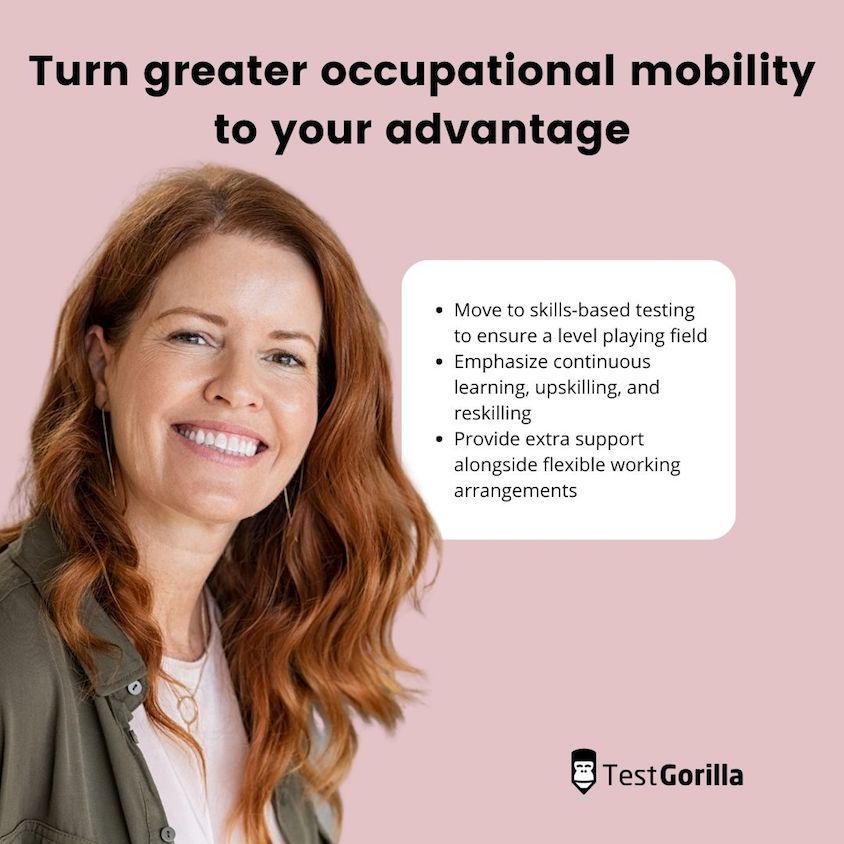Table of contents
The COVID-19 pandemic set in motion a chain of events that have irreversibly impacted occupational mobility.
Alongside the shift to remote and flexible working, the Great Resignation of 2021 saw employees quitting their jobs en masse. Reasons included frustration with confusing work-from-home policies, reduced work hours, health risks, pay, and lack of flexibility or opportunities for advancement. And it’s a trend that continues today.
At the same time, more and more industries are automating and adopting AI solutions. There is now a high level of AI being utilized in the retail, financial services, healthcare, and telecommunications sectors in particular.
This means candidates must fight to stay relevant in an ever-changing job market by switching role or even career as and when necessary.
In our recent report, the State of Skills-Based Hiring 2022, 49.3% of respondents switched careers within the past year. And yet many still face barriers to entry caused by biased hiring processes and the challenges of flexible working arrangements.
In this article, we’ll explore these issues and data from the report in more detail. We’ll also look at what can be done to allow companies and employees to take advantage of these new trends, stay relevant, and grow.
What is the current state of the labor market?
Data from the US Bureau of Labor Statistics shows that the Great Resignation is far from over, with over 4,000 Americans quitting their jobs in October 2022 alone. Despite issues with the economy, 21% of job seekers in that country alone report feeling so confident in the availability of jobs that they are happy to leave one without having another lined up.
Data from Pew Research also shows that in 2022, a lack of career advancement is the second biggest reason for this high rate of job exits. And, as technology increasingly takes over manual tasks like bookkeeping and assembly line work, people are looking to move into more personally fulfilling roles and avoid being made redundant by automation.
As author Jacob Morgan says, “Our organizations were originally designed for AI, but we just didn’t have the technology. Humans were forced to take on jobs that were mundane, repetitive, and mindless. Now that we have the technology needed… we can focus on being more human… on being creative, innovative, and empathetic.”
As people look for work that complements their skills and personalities, they also look to improve their work-life balance. The benefits of flexible work arrangements for employees are also still a major driver for occupational mobility. In one study focusing on the real estate industry, 54% of people said they would leave a job that didn’t offer flexibility on schedule and location.
Who has been most affected by increased occupational mobility?
Our report shows that a lot of candidates are moving into new industries, with finance and accounting, customer service, and IT top of the list.
While certain sectors lead the way, occupational mobility is high across many industries.Source: The State of Skills-Based Hiring 2022
During our study, we spoke to full-time workers from varied backgrounds in a range of positions. It’s interesting to note that career decisions are no longer dictated by increased educational attainment, with 44% of people moving into new roles already holding university degrees.
It’s also clear that it’s not just young service industry workers who are seeking new positions. Older, more established employees with many years of experience are also on the hunt for jobs that suit their lifestyles and offer new opportunities.
Across even high-level roles, people are seeking a significant change in occupation.
Source: The State of Skills-based Hiring 2022
However, in a job market that now spans five generations from Greatest to Gen Z, millennials still show the most drive to switch roles: 36.2% of individuals under 34 said they would be looking to change roles in the next two years.
Whether this uptick is due to the rise of AI or the trend of staying in job roles for less time, these new market conditions enable millennials to exercise greater control over their career paths. They are able to seek new opportunities that facilitate self-development and teach them new skills.
It is important to note though, that across all sectors, mobility has not been equal across demographics. In the next section, we’ll explore why this is the case and how companies can look to level the playing field.
The challenges of flexible work arrangements
Women are often disproportionately affected by the challenges of flexible work arrangements. Though flexibility around working hours and location is often essential for women, mothers particularly struggle with the blurring of home and work life, which may go hand-in-hand with reinforced traditional gender roles.
As labor market & welfare state researcher, Professor Heejung Chung says, “Women do a large chunk of the housework and childcare in heterosexual relationships… They are expected to — and do — exploit themselves at home. This means that working from home is used to expand childcare or housework hours.”
To promote equality, increased opportunities for flexible and remote working must be paired with support to help employees manage family responsibilities. Childcare services or paid family leave are two important solutions when looking to increase internal mobility or encourage employees to move from other industries.
Hiring inequalities
Even in 2022, there are still inequalities in hiring decisions. Our report shows that while 46.4% of women hope to switch roles in the next two years, fewer women than men have been hired in the past 12 months. And seven Black people to every white person was unemployed in 2022 according to data from the Economic Policy Institute.
The data also shows that recruiters are 13% less likely to click on a woman’s profile when making a hiring decision. Despite an increasing trend toward diversity and inclusion in the workforce, underrepresented groups are still clearly being discriminated against—consciously or unconsciously.
To level the playing field when it comes to occupational mobility, algorithms in applicant tracking systems (ATS) need to be configured for fairness. And, unfortunately, many traditional hiring methods like resumes and interviews are prone to bias.
In the case of CV-based screening processes, for example, analytics software may use information (such as gaps in work history perhaps due to childbirth) and eliminate potential candidates unfairly.
Challenges for graduates
In our report, we identify that many employers prefer to hire teen workers for low-skilled jobs and younger millennials for roles that require more experience. This leaves Gen Z graduates limited and forced to find work in areas that don’t align with their career objectives.
To further their challenges, Gen Zs also struggle to differentiate themselves during the application process. In our survey, 56% of respondents felt that a lack of relevant experience on their resume prevented them from landing a role.
_Traditional hiring methods do not allow recent graduates to distinguish themselves._Source: The State of Skills-Based Hiring 2022
How greater occupational mobility impacts companies
Greater occupational mobility gives companies access to a wider talent pool and scope to find exactly the right candidate for each role. The benefits of flexible working for employers not only relate to reduced overheads and increased productivity, but also allow companies to access and compete for global talent.
And a diverse team has a huge number of benefits for an organization, from broader perspectives and increased creativity to better decision-making and higher employee engagement. One study even showed that diverse companies earn 2.5 times higher cash flow per employee and inclusive teams are productive by over 35%.
The need to attract quality, diverse candidates in a market where people have more choice and are more careful about what they’re looking for means companies have to work harder to stand out. They need to focus on providing the job satisfaction and opportunities modern candidates expect and clearly showcase their value during hiring.
Improving recruitment and selection processes also means becoming more transparent about the hiring process and ongoing internal mobility. We’ll explore this more in the next section.
How can you turn occupational mobility trends to your advantage?
As Kathleen Hogan, Chief People Officer at Microsoft, says, there is a “powerful connection between wellbeing and performance.” To attract talent and showcase a focus on employee wellbeing, companies must also showcase opportunities for internal mobility and learning.
Illustrating where there is scope for upskilling and progression gets people interested and invested in your company.
And, in order to emphasize the fairness of this internal progression, companies should apply skills-based hiring. This approach focuses on hiring the best people for the role rather than qualifications, experience, or connections.
Skills-based hiring also aids occupational mobility further. Companies can pinpoint those who may be ready to transition across departments or industries and candidates can focus on learning skills in areas necessary for career advancement. These can also be based on soft skills—for example, people might undertake a leadership or management course.
Anonymized skills-based testing tools also allow employers to reduce bias while hiring prospective employees from across the world. These tools provide real-time insights that compare a range of candidates on skills, including everything from coding to branding strategy, culture-add, etc. By focusing on skills rather than qualifications or experience, you can level the playing field and hire happier, more productive, and more diverse teams.
Skills-based hiring: Turn greater occupational mobility to your advantage
In the wake of Covid-19, increasingly high numbers of people are leaving their jobs, changing departments or industries in search of increased flexibility and career progression. Artificial intelligence is also playing a key role in driving occupational mobility trends and leveling the playing field. As well as replacing humans in varied industries, tech-based hiring tools also help eliminate bias.
Across varied industries, positions, and educational backgrounds, candidates are seeking new opportunities. And though finance and accounting, customer service, and IT (all areas where automation has been deployed) are top of the list for mobility, other sectors are not far behind.
To ensure that all candidates – women, people of color, and recent graduates, in particular – have access to all of these new opportunities, companies should:
Move to skills-based testing to ensure a level playing field
Emphasize continuous learning, upskilling, and reskilling
Provide extra support alongside flexible working arrangements
This will allow organizations to hire and retain the best employees for each role, tapping into new trends in occupational mobility to fuel growth and future-proof their businesses.
Want to turn occupational mobility trends to your advantage?
Skills-based hiring can increase opportunities for both candidates and clients.
Related posts
Hire the best candidates with TestGorilla
Create pre-employment assessments in minutes to screen candidates, save time, and hire the best talent.
Latest posts
The best advice in pre-employment testing, in your inbox.
No spam. Unsubscribe at any time.

Hire the best. No bias. No stress.
Our screening tests identify the best candidates and make your hiring decisions faster, easier, and bias-free.
Free resources
This checklist covers key features you should look for when choosing a skills testing platform
This resource will help you develop an onboarding checklist for new hires.
How to assess your candidates' attention to detail.
Learn how to get human resources certified through HRCI or SHRM.
Learn how you can improve the level of talent at your company.
Learn how CapitalT reduced hiring bias with online skills assessments.
Learn how to make the resume process more efficient and more effective.
Improve your hiring strategy with these 7 critical recruitment metrics.
Learn how Sukhi decreased time spent reviewing resumes by 83%!
Hire more efficiently with these hacks that 99% of recruiters aren't using.
Make a business case for diversity and inclusion initiatives with this data.

